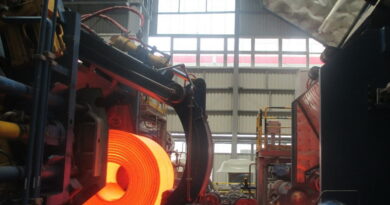PLATINUM: Recycling headwinds to ease, mined supply challenges remain
Global recycling supply in Q1’24 remained historically low at 390 koz, as weakness prevailed in both automotive and industrial recycling. For full year 2024, global recycling is projected to show some recovery, increasing by 5% to 1,642 koz.
Refined mine production rose 4% year-on-year in Q1’24 to 1,235 koz, driven primarily by a 5% year-on-year rise in South African production. For full year 2024, however, total mined platinum supply is forecast to decrease by 2% to 5,468 koz. South African supply is projected to decline by 2% due to cost-driven infrastructure closures offsetting increases from some expansion projects, while Russian output is set to decrease significantly by 9% to a multi-decade low due to planned maintenance and the impact of Western sanctions on business operations.
Above ground stocks are forecast to decline for the second year in succession, with a further 12% decline to 3,620 koz, hitting a four-year low.
Automotive platinum demand in Q1’24 at a seven-year high
In Q1’24, platinum demand in the automotive sector increased to 832 koz, the highest figure since Q4’17, benefiting from rising vehicle production and a greater hybrid vehicle share. Additionally, platinum demand was bolstered by the increased use of platinum-rich trimetallic catalysts, especially in North America where demand rose by 13% year-on-year.
Automotive platinum demand in 2024 is expected to grow by 2% to 3,269 koz. This is due to slowing consumer demand for battery electric vehicles (BEVs) and the continuation of growth in both heavy-duty and hybrid vehicle numbers, alongside stricter emissions legislation and an increase in platinum-for-palladium substitution, which is forecast to reach 742 koz this year.
Global platinum jewellery demand rose by 5% to 486 koz in Q1’24, supported by a strong increase in India and growth across most regions except China. Indian platinum jewellery fabrication saw a substantial jump of 53% to 59 koz, fuelled by a nine-fold increase in exports to the US and UAE, more men’s jewellery promotion, and new store openings.
Global jewellery demand is forecast to rise by 6% (+109 koz) to reach 1,978 koz in full year 2024, with demand in Europe projected to grow by 2% to a record high, North America expected to see a modest gain, the bridal market supporting demand in Japan, and, in the depressed China market, a slight year-on-year improvement. India’s full year growth is expected to match the increase in demand from Europe, North America and China combined.
With the completion of capacity expansion cycles in the glass and chemical sectors that boosted industrial demand to record highs last year, demand is forecast to decline as expected by 15% in 2024. Nevertheless, it will be 17% above the pre-COVID average (2013-2019) at 2,242 koz.
Chemical demand is expected to fall by 33% to historical norms of 529 koz in 2024. Similarly, glass demand, which actually increased in Q1’24, is expected to fall by 25% to 524 koz in full year 2024. Medical sector and hydrogen-based application demand are both expected to grow in 2024, while demand from the petroleum, electrical, and other industrial sectors will remain broadly similar to 2023 levels.
In Q1’24, global bar and coin investment dropped to 64 koz due to sharp year-on-year declines in Japan and North America, which offset gains in Europe and China. Platinum ETF holdings saw an overall increase of 11 koz to 3,077 koz, with gains in Western-held funds partially offset by declines in South Africa. In 2024, net platinum investment is expected to remain positive for the second consecutive year at 99 koz. In North America, bar and coin demand remains above pre-pandemic levels, and is expected to continue to do so for the full year. China’s retail investment in platinum is forecast to exhibit double digit growth to 60 koz, driven by a perception that the metal is being undervalued relative to gold. European investment will likely stay flat due to high interest rates. Meanwhile, platinum ETF holdings are projected to decrease by 120 koz to 2,946 koz, as high interest rates continue to discourage investment in non-yielding assets. The change in Stocks Held by Exchanges (combined NYMEX and TOCOM) is expected to increase by 38%, albeit to only 20 koz.




